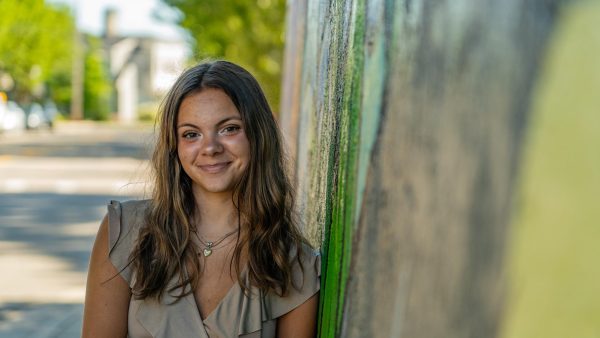Alaina Lundgren’s unique outlook on life is largely by virtue of the presence of a rare disorder
Alaina Lundgren remains content depsite the struggles she faces along the way.
During her childhood, senior Alaina Lundgren had begun to realize that it’s not exactly normal for her joints to pop out of their sockets on a daily basis. While speaking to other people about it, she would get nothing but looks of concern, confusion, and often fear in return.
Contrary to her prior belief, this wasn’t normal, and it would only progress with time. So, ultimately, after over a decade of living with this, she finally was given an answer: Ehlers-Danlos Syndrome.
Ehlers-Danlos Syndrome, or EDS, is a genetic connective tissue disease plaguing merely 200,000 people yearly, classifying it as a rare condition. Alaina is one of those 200,000.
“It was years of medical gaslighting from my doctor when he would insist that it was just tendonitis and that I would grow out of it,” Alaina said. “I could move my arm, and my shoulder would just pop, and something would feel wrong, or I would wake up and not be able to walk because my hip would hurt so bad; I didn’t know exactly what was wrong, but I knew that something wasn’t quite right.”
There is rarely any respite from the pain in Alaina’s case and that of the others suffering from this.
As EDS is a progressive condition, it gets worse over time. Though it varies between patients, it is most common for symptoms to begin in childhood and become worse during adolescence and young adulthood.
“It started where my knees would hurt when I ran,” Alaina said, “and then, all of a sudden when I would wake up in the morning or would lay in a certain way, my hip would start to slide out a bit. My one shoulder has always had the subluxation issue, but it eventually carried to the other one, too. My collarbone started dislocating, my sternum has issues—it’s weird. Now, we’re at the point where I get chest pain when I run.”
The confusion associated with not knowing was the hard part, right alongside the chronic pain she felt, and continues to feel, so frequently.
The experience of trying to talk to people about it, in particular, was a large part of what tipped Alaina off to the idea that it might be more severe than she had thought.
“I would try to talk to people about it,” Alaina explained. “Every time, they would say, ‘I don’t know what you’re talking about, that’s weird.’ Every time, I was like, ‘perfect.’”
Despite her sarcasm in regard to the concept, it’s an exceptionally difficult ordeal altogether, for Alaina and for everybody else left in the dark with this insufficiently researched condition.
Medical physicians often aren’t fully educated on this condition, and this lack of understanding of Ehlers-Danlos is extremely harmful to everybody with the disease.
“Honestly, I keep finding people who can relate, and it’s really concerning if they don’t know what I’m talking about,” Alaina explained. “Sometimes, I’ll bring something up to somebody, and they’ll say, ‘me too,’ but I know that it’s not normal; please get it checked out.”
Oftentimes, people don’t realize they have EDS simply because they’re uneducated. Alaina was lucky enough to receive a diagnosis, but many people aren’t.
The availability of doctors to accommodate the questioning patients is scarily low, too—all being on opposite corners of the country and dismissing people semi-frequently despite knowing nothing about their medical history.
“It’s underresearched, and the research that is being done is super underfunded,” Alaina said. “It’s got to be more than 200,000 people a year, but that’s just how many people are diagnosed. Plus, it’s so hard to get a diagnosis. It’s just disappointing because why do I have to ask about what’s wrong with me for upwards of ten years, and just now be getting an answer?”

Eva LaBeau is a senior entering her second year on The Central Trend. She takes on everything she does with great passion, specifically when relating to...



























































































